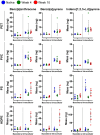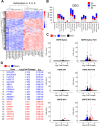Nanoplastics Enhance Transmembrane Transport and Uptake of Carcinogens: Transcriptional Changes and the Effects of Weathering
- PMID: 40538222
- PMCID: PMC12376499
- DOI: 10.1002/advs.202507355
Nanoplastics Enhance Transmembrane Transport and Uptake of Carcinogens: Transcriptional Changes and the Effects of Weathering
Abstract
Nanoplastics are generated from common consumer plastics (polyethylene terephthalate, high-density polyethylene, polystyrene, polyvinyl chloride) and exposed to simulated marine weathering for up to 10 weeks. Fourier-transform infrared spectroscopy and ζ-potential measurements reveal continuous changes in the composition of the nanoplastics, consistent with oxidation. Although the chemical composition and oxidation of the nanoplastics influence their ability to sorb polycyclic aromatic hydrocarbons (PAHs), for all investigated conditions, sorption of PAHs to nanoplastics achieves effective PAH concentrations that are orders of magnitude higher than the solubility limit in water. In an intestinal co-culture model membrane consisting of M cells and enterocytes, PAH-loaded nanoplastics enhance the overall PAH transport into and across the membrane, with HDPE achieving the highest intracellular PAH concentration. RNA sequencing of cell membranes exposed to nanoplastics reveals significant transcriptional changes, including upregulation of oxidative stress and detoxification pathways (NQO1, CYP1A1, CYP1B1), especially in response to PAH-loaded nanoplastics, while genes associated with basic cell functions, such as DNA repair (MACROD2) and division (KIF20A), are downregulated. These findings confirm the feasibility of nanoplastics to increase bioaccessibility and bioavailability of hydrophobic carcinogens and enhance cellular stress, which underscores the potential environmental and health impacts associated with nanoplastics as carriers of hydrophobic environmental toxins.
Keywords: RNA; intestinal membrane; nanoplastics; polycyclic aromatic hydrocarbons (PAHs); transmembrane transport.
© 2025 The Author(s). Advanced Science published by Wiley‐VCH GmbH.
Conflict of interest statement
The authors declare no conflict of interest.
Figures






Similar articles
-
Prescription of Controlled Substances: Benefits and Risks.2025 Jul 6. In: StatPearls [Internet]. Treasure Island (FL): StatPearls Publishing; 2025 Jan–. 2025 Jul 6. In: StatPearls [Internet]. Treasure Island (FL): StatPearls Publishing; 2025 Jan–. PMID: 30726003 Free Books & Documents.
-
AI-assisted systematic review on remediation of contaminated soils with PAHs and heavy metals.J Hazard Mater. 2024 Apr 15;468:133813. doi: 10.1016/j.jhazmat.2024.133813. Epub 2024 Feb 17. J Hazard Mater. 2024. PMID: 38402679
-
Management of urinary stones by experts in stone disease (ESD 2025).Arch Ital Urol Androl. 2025 Jun 30;97(2):14085. doi: 10.4081/aiua.2025.14085. Epub 2025 Jun 30. Arch Ital Urol Androl. 2025. PMID: 40583613 Review.
-
Health risk assessment of polycyclic aromatic hydrocarbons in common food crops within and outside selected mining areas of Ebonyi State, Nigeria.Sci Rep. 2025 Jul 10;15(1):24982. doi: 10.1038/s41598-025-87623-2. Sci Rep. 2025. PMID: 40640419 Free PMC article.
-
Evaluation of 7 urinary metabolites of polycyclic aromatic hydrocarbons during a wildfire response as part of the Wildland Firefighter Exposure and Health Effects Study.Ann Work Expo Health. 2025 Jun 30;69(5):559-567. doi: 10.1093/annweh/wxaf024. Ann Work Expo Health. 2025. PMID: 40443254 Free PMC article.
References
-
- OECD , Global Plastics Outlook: Economic Drivers, Environmental Impacts and Policy Options, OECD, 2022.
-
- Jambeck J. R., Geyer R., Wilcox C., Siegler T. R., Perryman M., Andrady A., Narayan R., Law K. L., Science 2015, 347, 768. - PubMed
-
- Andrady A. L., Mar. Pollut. Bull. 2022, 180, 113761. - PubMed
-
- Arp H. P. H., Kühnel D., Rummel C., MacLeod M., Potthoff A., Reichelt S., Rojo‐Nieto E., Schmitt‐Jansen M., Sonnenberg J., Toorman E., Jahnke A., Environ. Sci. Technol. 2021, 55, 7246. - PubMed
MeSH terms
Substances
Grants and funding
LinkOut - more resources
Full Text Sources
Miscellaneous
